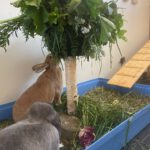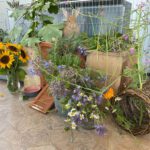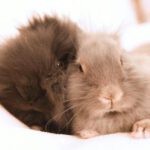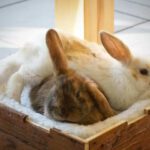Contents
- Fit and happy through the winter
- Get rabbits well through the winter
- Which rabbits are suitable for keep them outside during the winter?
- Can I keep a rabbit during the winter alone outside?
- Is it sensible and necessary to gradually get used to the outside temperatures?
- Are all breeds allowed to spend the winter outside?
- Does my rabbit have to be brought into the apartment if it suddenly falls ill in winter?
- What requirements must the enclosure meet if my rabbits spend the winter outside?
- What is particularly important for daily care and maintenance in winter?
- Extreme sub-zero temperatures and artificial heat supply
- What to do if the water freezes?
Fit and happy through the winter
Get rabbits well through the winter
A well planned outdoor posture is by no means problematic. Rabbits usually tolerate snow and frost better than heat in summer.
When the first leaves fall and it gets colder at night, it is time to think about what the rabbits need in winter and how to meet them.
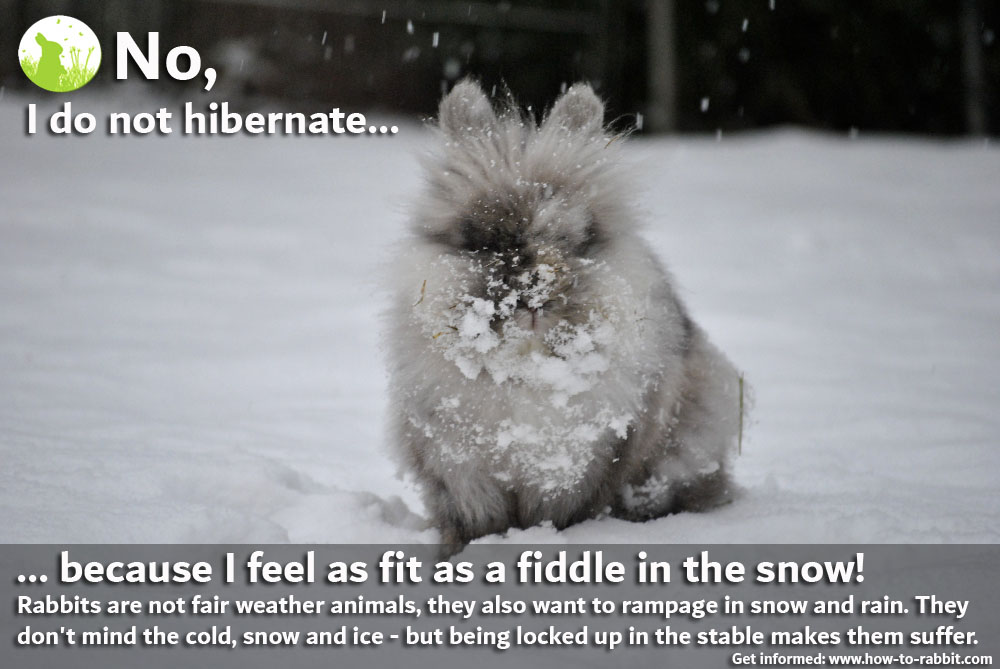
Which rabbits are suitable for keep them outside during the winter?

Most rabbits, but not all, can live outside in winter. Basically, the rabbits have to be healthy and fit. Young rabbits can also spend the winter in the garden without any problems.
Not suitable are all weakened animals! No matter whether the rabbit is extremely weak in age or not properly fit by a chronic illness: Keeping them outside in the garden is a taboo for such animals.
Can I keep a rabbit during the winter alone outside?
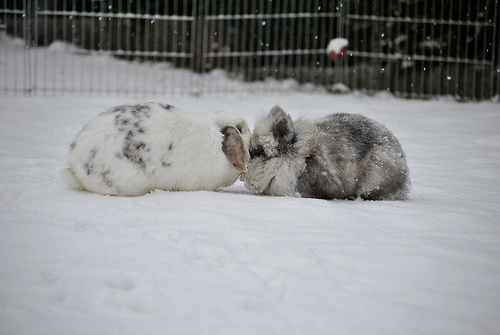
Especially in winter, a rabbit is indispensable. By cuddling together, the rabbits stay warm and the shelter is heated up faster by the body heat of the rabbits. Besides, two rabbits are clearly more active than one alone.
Why does my rabbit need a second rabbit?
Getting foreign rabbits used to each other
Is it sensible and necessary to gradually get used to the outside temperatures?
In order not to stress the organism unnecessarily, a gradual adaptation to the outdoor posture must be carried out in any case. This can take place over the summer/autumn by moving the rabbit outside at room-like outside temperatures or by a gradual habituation. The ambient temperature of the room is gradually reduced (leave windows open during the day, later at night, the rabbit during the day first for hours, then all day outside and at night again, later in mild nights and finally completely outside).
Are all breeds allowed to spend the winter outside?
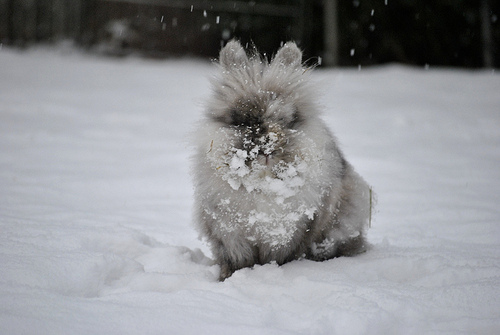
Some breeds are particularly weather-sensitive (e.g. long-haired animals, some lion heads and Rex rabbits). Due to the changed hair structure, they can keep the body heat better than other animals and there is a lack of a dense layer of the top coat which makes water and snow roll off. Therefore, these rabbits must live in a largely roofed enclosure, which is also protected from moisture on several sides. Uncovered free-running areas are no problem, even in snow and rain. These breeds are allowed to run in the garden and they can go back to the covered enclosure at any time. Long-haired animals should not be shorn but should be given a haircut that does not restrict their movements. In addition, the hair must not hang on the floor. For these animals, a preferably clean substrate (stone slabs instead of sand or soil) is recommended.
Does my rabbit have to be brought into the apartment if it suddenly falls ill in winter?
If a rabbit is weakened for a short time during the winter, due to a sudden illness, it is not advisable to bring it suddenly indoors. The temperature difference unnecessarily burdens the small, sick organism. If an animal is only temporarily weakened, it must be accommodated in a frost-free but cold room (laundry room, cellar, unheated room…) until it has recovered. Then it can be relocated step by step outside again without any problems. Tearing the rabbit out of the group means considerable stress, therefore, if the disease is not acutely contagious, should be refrained from a separation. The sick rabbit can move to the frost-free area together with the group or at least with a fellow rabbit. Many diseases go hand in hand with timely treatment without weakening, so that the rabbit can be left outside in its familiar environment.
What requirements must the enclosure meet if my rabbits spend the winter outside?
In order to offer the rabbits a cozy home for the winter, the enclosure must fulfil some basic requirements that make a pleasant stay during the winter possible.
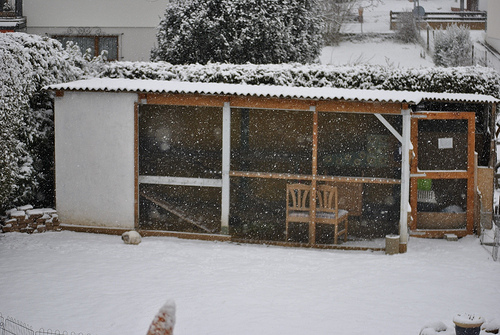
- A plenty of space for species-appropriate movement sequences
Only active rabbits stay fit in winter! An enclosure with several square meters of unadjusted space is therefore mandatory. Additionally, during the day free garden run or free run in a fenced area is recommendable, so all rabbits remain fit and active. See: How much space do rabbits actually need?
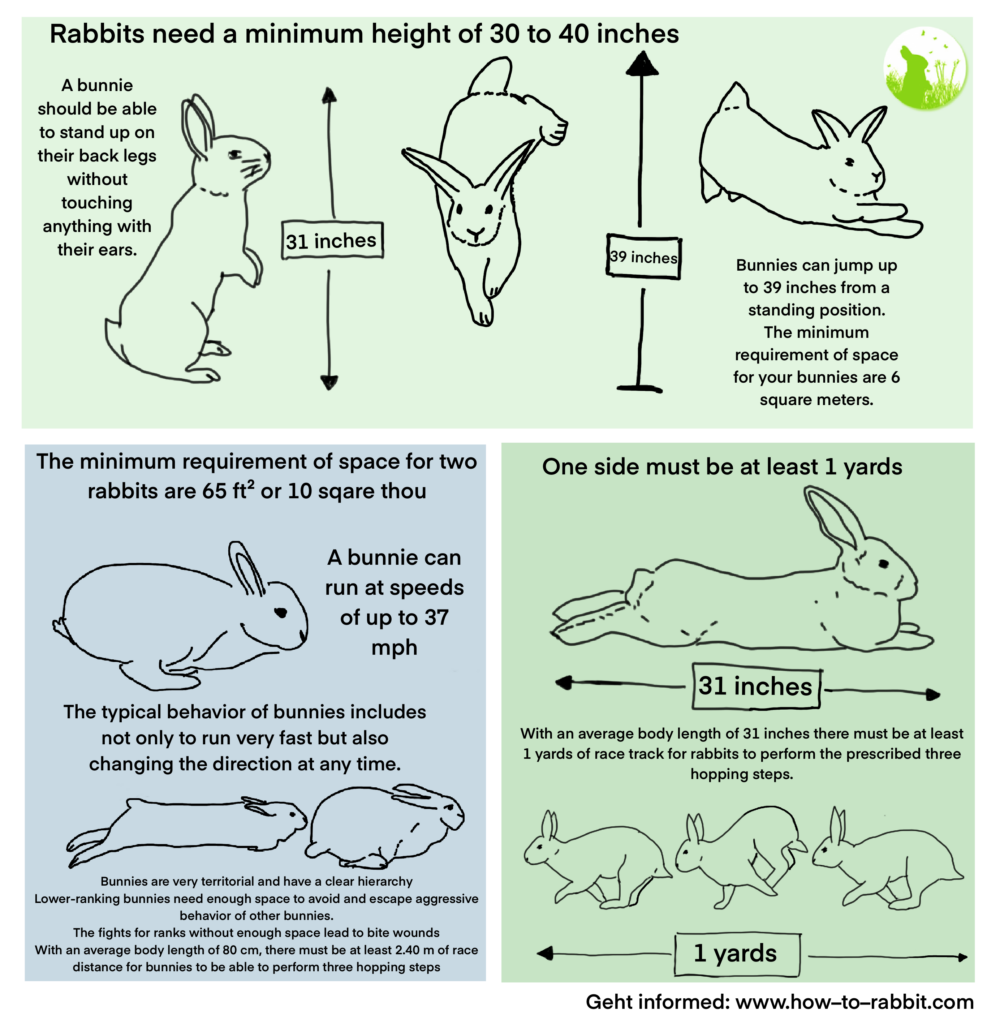

- A protected area that is not exposed to rain, wind or snow.
A corner or a larger area of the enclosure should be absolutely weatherproof. This is achieved by roofing the enclosure and protecting it from weather (e.g. covering it with tarpaulins, rolled glass or wood paneling). Building recommendations and proposals for solutions: The outdoor enclosure – what is to be considered?
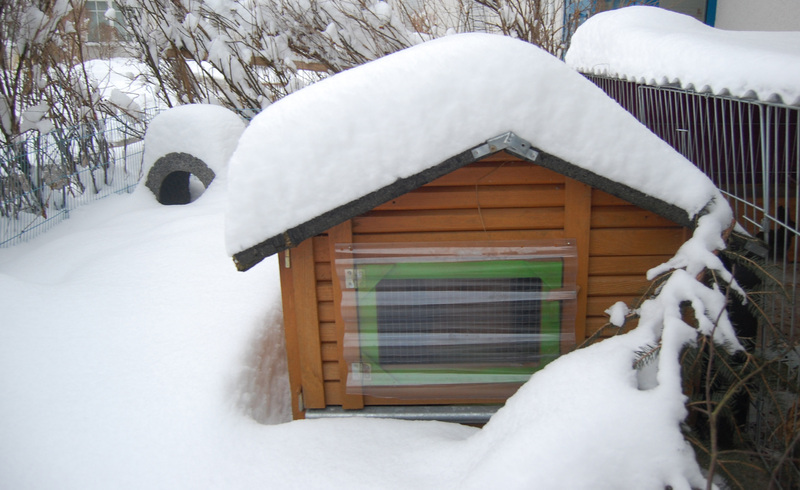
- A shelter: A rabbit hutch in which the rabbits are absolutely protected from wind, rain, draughts and snow and where the rabbits can „increase“ the temperature with their body temperature is recommended. That the rabbits are able to warm up the hut quickly, it must be small but it should still offer enough space to lie down, eat, drink and sleep. The right size therefore depends on the size of the rabbits, in a large group several small shelters are recommended.
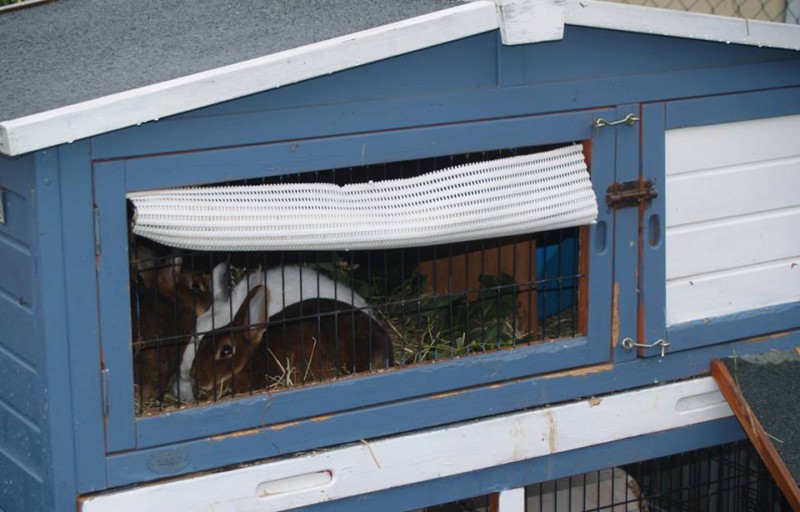
You should protect barred doors additionally, without the air circulation is prevented (as it is the case with an insulation with Styrofoam). With a curtain wool blanket, a towel, cloths, Plexiglas, roll glass or wood one can cover the lattice.
However, insulation is not necessary and is usually harmful to health: see: Keeping myths
In frosty weather, a lot of hay and straw should be sprinkled in, so that the rabbits are cuddly.
Especially with unharmonious groups, two entrances are recommended, these should of course not point towards the weather side.
Never lock rabbits in a shelter, it’s like living in a freezer. They need in principle an attached, marten-safe run, which can be used day and night.
> rabbit keeping in the garden
What is particularly important for daily care and maintenance in winter?
- Cozy and warm/insulating bedding

The shelter and other corners should be generously padded with fresh, absorbent and insulating bedding. Some rabbits also like it when the shelter is stuffed with hay and build a cozy hiding place. The bedding must never be wet or damp, so daily bedding and regular cleaning is a must! On wet litter the rabbits get sick and wet litter does not keep warm from below. Suitable is an absorbent base (pellets, wood litter etc.) with straw or hay bedding.
- Sufficient observation time for the animals
Even if it is cold outside, the animals must not be neglected. The rabbits should be observed daily in order to detect changes and diseases at an early stage.
- Enough energy-rich and fresh food
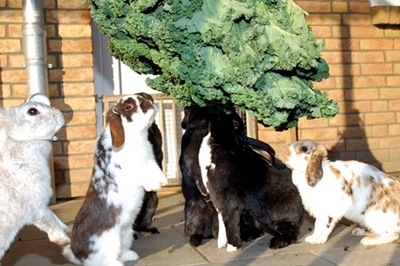
In autumn, rabbits begin to eat to fatten-up for winter that protects them from minus temperatures in the cold season. That is why it makes sense to start feeding a seed mixture, one or two corncobs, lots of fruit and plenty of fresh food when the first leaves fall from the trees.
- Food suitable for winter
Also in winter a lot of fresh food is obligatory. However, since it freezes at minus temperatures, care must be taken to provide enough dry feed components (dried herbs, hay, seeds) and to switch to fresh feed whose cells can also withstand frost (fruit, cabbage, sugar beet…). Other vegetables are not eaten during frost and should therefore only be offered in small quantities (for immediate consumption). It is therefore important to feed as often as possible in winter. Continuing
Extreme sub-zero temperatures and artificial heat supply

It is possible to provide some warmth in winter by using a heat source in case of severe frost. However, healthy rabbits do not necessarily need the artificial heat, because rabbits are not sensitive to cold.
- A heating pad for pets (Snuggle Safe) can always be offered, even if there is no electricity. However, experience has shown that it cools down very quickly in cold weather (in severe frost it lasts just three hours) and can only be warmed up in a microwave.
- Experience has shown that normal hot-water bottles which are wrapped in a cloth or pillowcase should be protected from bites for just as long or even longer.
- A Thermo Master heating mat is recommended for enclosures that have a power connection, it does not need to be reheated regularly because it produces the heat itself through the power.
- A self-heating thermal blanket can be used without a power supply. To protect it from gnawing, a close-meshed wire mesh can be placed around the inside of the ceiling and only then can the cover be pulled on.
- With a heat or red light lamp it is possible to provide heat in large shelters or roofed enclosures. If one offers food and water depending upon equipment at, under or on the warmth, it remains frost-free. In addition, the rabbits sit down also gladly to the heat source and many devices heat also the shelter with.
- Heated shelters can also be used, so the water and food in the shelter remains frost-free.
- For dogs warming plates are available in the trade, warming plates for the chick breeding are likewise suitable. Also all other heat sources (heaters etc.) are conceivable.
It is important, however, that the rabbits can choose at any time whether they want to escape the heat or expose themselves. In addition, pay attention that there is enough distance to devices and/or to the bedding and to the rabbits, so that it comes to no burns and no fires. It is also important not to get too hot.
What to do if the water freezes?
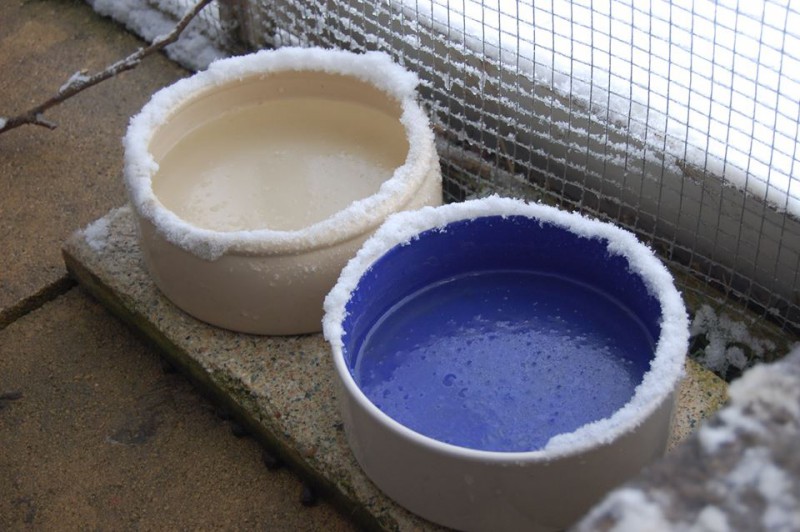
Water supply during frost
When the first frosts sets in, the water freezes regularly. Therefore, I would like to give you a few tips to make the water supply easier in winter.
Nipple drinkers are completely unsuitable for the water supply. From nipple drinkers the water comes only drop by drop, the rabbits cannot drink properly. They are also unhygienic. In winter there is a danger that their small tongues will stick to the frozen metal and injure themselves when they tear off their tongues.
Some rabbits eat snow in winter to absorb water.
Tips against freezing
- It is best to buy three bowls at once, so you can bring the frozen bowl into the house and let it thaw slowly. If the third bowl is frozen, the first one is defrosted in the meantime and can be used.
- In the shops there are heatable bowls for dogs for about 35€. Their cable is protected with a steel sheath against gnawing. If one has a power connection near the enclosure, then one can attach a warming bowl which saves a lot of work in winter and is a good possibility, especially for working rabbit friends, to provide the rabbits with fresh water around the clock.
- It is also possible to use an electronic water warmer (approx. 20€) for chickens, which is simply placed under the bowl. However, the cable must be secured against gnawing, e.g. by leading out of the enclosure or by placing a stone on top.
- Without electricity you can put a Snuggle Safe under the bowl. It is heated in the microwave in 3-8 minutes and then keeps the bowl frost-free overnight.
- If you have a stove you can heat flat stones or stone slabs on the stove and place them alternately under the water bowl. Or place hot stones in the bowl.
- Who attaches a heat source for the rabbits in the enclosure (see above) can set up the water in the proximity of these, so that it remains frost-free by the warmth.
- Meanwhile there are also heated drinking bottles without nipples which are suitable.
- Offer snow in a bowl in addition to the water, if this is frozen, many rabbits eat the snow.
- Place a burial candle sheltered from the wind in a planting stone or your own construction, cover the scaffold with a thin plate and place the water on top. These candles usually last about two days and then have to be replaced again.
- If you let 2 table tennis balls float on the water surface, the water freezes more slowly by the constant movement of the balls with light frost. However, this only works with very large bowls. The bowls should be positioned so that the wind moves the balls.
- The more water that fits into the bowl, the slower it freezes, so very large bowls are ideal.
- If the bowl is placed on an insulating base (wood, polystyrene cover protected with wood from being gnawed, etc.), the bowl will freeze much later. On a stone or a metal plate the bowl should not stand in winter, here it freezes particularly fast.
- Do not make bowls that are bent inwards completely full! Water expands during freezing and causes the bowl to burst. Therefore, only fill the water bowl just below the curvature.













